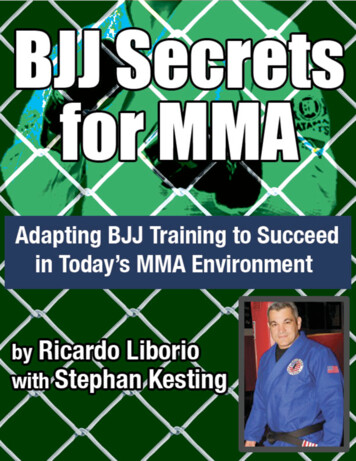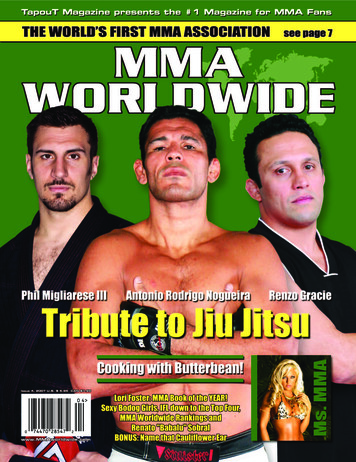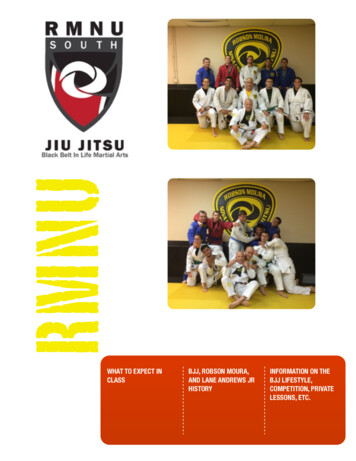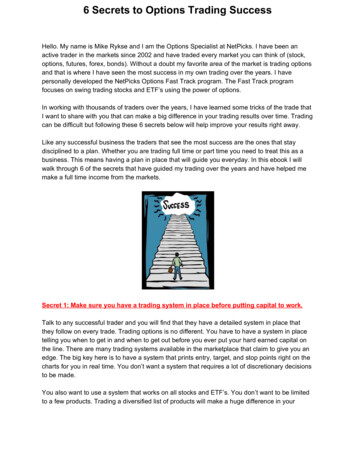
Transcription
BJJ Secrets for MMAAdapting Brazilian Jiu-Jitsu to Succeedin Today's Mixed Martial Arts EnvironmentAn exclusive interview with Ricardo Liborio of American Top Team(www.americantopteam.com)by Stephan Kesting(www.grapplearts.com.com)Ricardo Liborio is a legend in Brazilian jiu-jitsu, and he's well on his way toconquering the MMA world as well.This articulate and thoughtful man is not only a famous BJJ black beltunder the late Carlson Gracie Sr., but he's also the head coach and coowner of the MMA powerhouse American Top Team (ATT).Based in Coconut Creek, Florida, ATT has trained many of the top MMAfighters competing (and winning) in the UFC and other big shows.The questions for this interview were submitted by the Grappleartsreadership. Stephan Kesting then took what people wanted to know aboutBJJ and MMA training, and interviewed Ricardo Liborio in March, 2009.For more information on Ricardo Liborio and/or ATT please visitwww.americantopteam.comPlease note: this article is one of the resources availableto readers of the 'Grappling Tips Newsletter'.To sign up for this FREE newsletter and access other exclusivecontent please go to www.grapplearts.com/newsletter
Q: What does a typical BJJ class for beginners look like?A: For beginners it all depends. First we try to find out if this guy has any martial arts orcombat sports experience. If he has 8 years of wrestling and you put him with a 45 yearold guy who just wants to train for fun then that second guy is gonna get hurt.Our typical plan is to give a new student 2 weeks of basic half hour classes - 6 classesin total. Here they learn how to fall, how to roll, what the positions like mount and guardare, how to tie a belt.From there they can go to the regular classes. We have beginner, intermediate,advanced and competition classes. We often have two classes going on the mats atthe same time, because we have a lot of mat space. So we have a lot of options if youwant to go pro.In the regular classes we always do some sort takedowns as a warmup. Firsttakedowns, THEN the ground. Everyone has to learn this - there is no way to avoidtakedowns at our school.Also, we don't allow purple, brown and black belts to train with beginners. I don't mixthem with white belts unless I really trust them and they know what they are doing.MMA sparring is three days a week, and at least 2 hours long. You have to be seriousabout sparring if you want to compete. The competition classes (with a LOT of sparring)are on Tuesdays, Thursdays and Saturdays.Q: How do you teach MMA to beginners?A: At ATT we start everybody with BJJ - BJJ comes first.Even if a new guy comes in with 15 fights in Muay Thai then he still needs to learn thebasics just like everybody else. But you also can't compare this high level athletic guyto a recreational player who is forty years old.Also we have the green belt - it comes between white and blue belt. This was a hugegap in North America and the green belt fills the gap wonderfully. Here guys don't, orcan't, train for 3 to 4 hours a day the way they do in Brazil.It's very rare to jump from white belt to blue belt at ATT - only if the guy is training everyday and comes to every class then sometimes - maybe - he can go directly to blue belt.
Q: How do the professional fighters at ATT typically schedule their training. Whatare the different components (e.g. Sparring, strength, cardio, technique.)?A: Our fighters have a schedule. They train twice a day, six days a week. ActuallySaturday is just one session, so they've really got 10 or 11 sessions in a week.How they structure their training depends on whether or not they have a fight coming upIf he's between fights, and he's just trying to improve, then he has a bit more flexibility inhow and what he trains.But if he has a fight coming up then you have to look at what they need. A typicaltraining camp is 8 to 10 weeks, and you have a strategy for the fight. Everythingdepends on who his opponent is. If his strategy in the fight is going to be to sprawl onhis opponent's shots, then he's going to be doing a LOT of sprawling.In general, the group classes cover the basics of everything, and the one-on-one privatesessions go more into strategies.Q: Is it possible to train at the level of a pro fighter while still working a full time"regular" job?A: I believe it is possible for anyone to succeed if they've got the right state of mind andthe right passion. But to go to the highest level of fighting it's not possible.Maybe it's possible to become a B level or a C level fighter, but to become an A levelfighter - no way. To fight at this level a fighter needs to go home and rest betweentraining sessions. If he goes to work instead then it' s not the right thing to do. AskGeorges St. Pierre if he has another job.Ricardo Liborioa Carlson Gracie Black Belt
Q: What do you think of the debate over crosstraining in different martial arts vs.concentrating on one art - jiu-jitsu for example - and then trying to exploit thevulnerabilities of other martial arts?A: I think that you need to cover your deficiencies and weaknesses in all areas withcross training.Of course I believe that jiu-jitsu is the most efficient martial art out there. If youseparated them and you had the clash of the styles between equal physical abilitiesthen jiu-jitsu would win 100% of the time. Royce Gracie proved this long ago.But jiu-jitsu is different from MMA, and MMA is a different world now. If you don't train inthe different areas then you're not competing at the highest level.If you're not training in striking and takedowns then you're not going to be a good MMAfighter. If you avoid the other martial arts then you're avoiding learning, and you need tokeep on learning.Here's an interesting thing. Let's say that you're really good at jiu-jitsu, and you want todevelop your striking skills. To get better at striking you have to dedicate yourself to it,and of course your striking will suck at first. But at the same time your jiu-jitsu skills aregoing to suffer because you're not training that area very much - you won't be sharp onthe ground either. So now, for a while, you're going to be in a phase where you thinkthat you suck at everything.This is normal - it's part of the game. Just keep going, keep going, keep going. You'reeventually going to become a very well rounded guy. A guy who can fight standing up,and wrestle, and grapple. It's just time.You cannot just do the things you like doing and hope to become a complete MMAfighter.Q: Which UFC fighter has the best jiu-jitsu right now?A: The perfect example is Demian Maia. He's done the transition from BJJ to MMAmore efficiently than anyone else I can think of right now.He doesn't miss the position and goes straight for the submission. Demian Maia is soquick, efficient and fast.MMA is NOT BJJ. If you're terrified of losing position in MMA then you make the fightboring.
Q: If an untrained person wanted to eventually fight in MMA would you make themtrain BJJ with the gi first?A: Somebody without BJJ experience should definitely train with the gi - they have to doit because it's the core of the art. After a while of training with the gi, it depends on hisscheduleQ: What would you do if you had a BJJ world champion (with the gi) who wantedto make the transition to MMA?A: You have at least three different types of jiu-jitusu: jiu-jitsu WITH the gi, jiu-jitsuWITHOUT the gi, and jiu-jitsu for MMA. These are three different things. Someonepounding your face changes everything! All of a sudden you can't do a lot of things onthe ground that you could do before, without striking being involved.So if I had a BJJ world champion training for MMA my suggestion would be for him toput his gi aside and work his no-gi skills. Then he has to transition to the MMAenvironment. For example he has to learn to deal with strikes on the ground, but alsowith someone who's only goal is to stand up and back away from him on the ground.Put someone in your guard, and see what it's like if all he wants to do is put his handson your biceps, stand up and back away. This is very different from regular jiu-jitsu.So you've got to start no gi training and jiu-jitsu training for MMA. It's a huge realitycheck for most people.Q: It's very frustrating to watch MMA fighters (including those in the UFC) makegrappling mistakes that most BJJ Blue belts know to avoid. So how much effortdo you think it is to add good, solid BJJ techniques into the MMA game?A: To develop a good solid BJJ game and to apply BJJ in MMA you need to have goodcoaches, especially to cover the basics which are so neccesary.High level jiu-jitsu with fancy flips and crazy transitions is amazing to me, but if a highlevel wrestler wants to start MMA then he needs to get good at the BJJ basics. This willmake a huge difference to his fighting ability.Just to show you how important a good coach and a good school is, it's not uncommonto find good blue belts who can kick the ass of many fighters on the ground. And that'sall because he's got strong basics.
Q: How does one train to fluidly mix strikes on the ground with your grappling?Are there specific drills to train that?A: Yes we have a lot of drills to cover this aspect of training, and it's not only in jiu-jitsupractice that the fighters do this. The conditioning coach also teaches and trains thisaspect.When you ground and pound somebody you still need to grapple all the time. The guygetting pounded won't just lie there - he'll try to get away, and you need to be grapplingthe whole time to establish and maintain your position.There are specific drills and technique series we do to develop this. You hit the guy one two three - and then he reacts in a certain way and you respond by doing the nextthing. You need to do a lot of repetition of this to become smooth and fast.Q: What is the best way for a fighter to spar MMA and practice their ground £ without killing their training partner?A: Oh my God - this is a very difficult problem for everyone training and coaching MMA!If you know the answer maybe you can tell me! *laughing*You've really got to go light. You've got to control your intensity and the guy receivingpunches needs to be understanding about any small accidents.If you want to go hard with your ground and pound use a punching bag on the floor.Now you can really let your hands go.If you go hard with a partner you're going to hurt the guy. Then he'll hurt you back andnow you've got a real fight with bad feelings. That's how you lose training partners.Guys DO get excited though, especially before a fight. The coaches try to watch out forthis and keep tempers down.Also, after the practice we make sure that everybody shakes hands. You can go hardduring the training session, but afterwards everyone has to share the love. The bottomline is push your partner to the limits, but try not to hurt someone from your school
Q: Sometimes you see fighters hitting focus mitts or thai pads in a way that isboxing or kickboxing-oriented rather than MMA oriented. What kind of standuppad work is best for MMA?A: In MMA you usually see one, two or three punches. You rarely see more than threepunches, unless the guy is already out.In this sport you have punches, elbows, knees, kicks and takedowns. A five-punchcombination is possible, but usually you hit the guy with one or two shots and then heclinches. If you're getting the better of him in the standup then he'll go for the takedown,or even pull guard.So keep it simple - three punch combos maximum. Unless he's already hurt, or you'retraining for stamina purposes.Also the angles are very important - you need to know how to change them and switchbetween attacks. Always have a plan B: you start with a strategy to set up yourcombination, but if he defends it you need to know how to flow and adapt.Q: What advice do you have on diet and nutrition for fighters? What are the mostcommon dietary mistakes that fighters make?A: The most common mistake fighters make is to try and lose too much weight right inthe end, just before the fight. You need to prepare yourself with a healthy dietbeforehand.If you try and lose all that last-minute weight through dehydration you can really hurtyourself, and even die! Losing 15 pounds in 2 days can shut your kidneys down if youdon't know exactly what you are doing.My big tip here is that to compete at a high level you need to look for a nutritionist towork with you on these things. We have a nutritionist at ATT who really helps ourfighters with nutrition and the dehydration-rehydration process.Also keep in mind that you lose a lot of weight at the beginning of a training cycle you're doing more cardio and you can eat more.Closer to the fight you're training less intensely because you can't get cut, you can'tbreak your nose. You're not going full speed anymore and you have to eat slightly lessto stay on track.And of course you avoid sweets, avoid fried foods and excessive carbohydrates
Q: Are there any supplements that almost all MMA fighters are taking?A: Our nutritionist takes care of all that stuff. We're sponsored by Champion's Nutritionand our fighters get their vitamins and most of their supplements from them.Of course there are a lot of supplements; you have supplements for losing weight,gaining muscle, increasing stamina. BUT you need to be careful, because asupplement that benefits you in one area could hurt you in another.Keep in mind that nutrition is important - and without proper nutrition all the supplementsin the world won't help you.Also understand this - if you've got great nutrition but bad technique then you're stillgonna lose! Conditioning is also important if two people have equal skill levels. Youcan get high level black belts get their guards passed simply because they'reexhausted!Q: How do you relax when someone is trying to choke you out, or take your armoff, or punch you in the head?A: It comes down to having the knowledge of
But jiu-jitsu is different from MMA, and MMA is a different world now. If you don't train in the different areas then you're not competing at the highest level. If you're not training in striking and takedowns then you're not going to be a good MMA fighter. If you avoid the other martial arts then you're avoiding learning, and you need to keep on learning. Here's an interesting thing. Let's .











